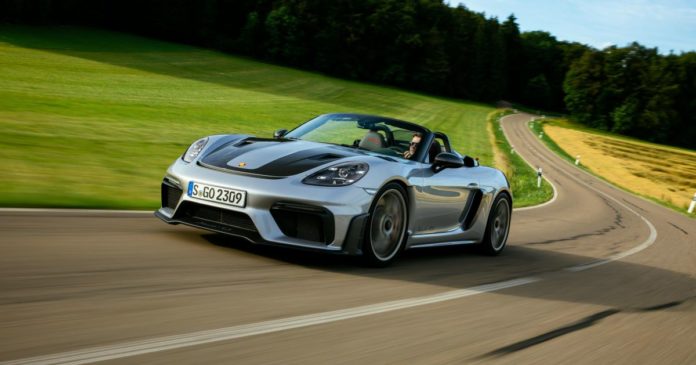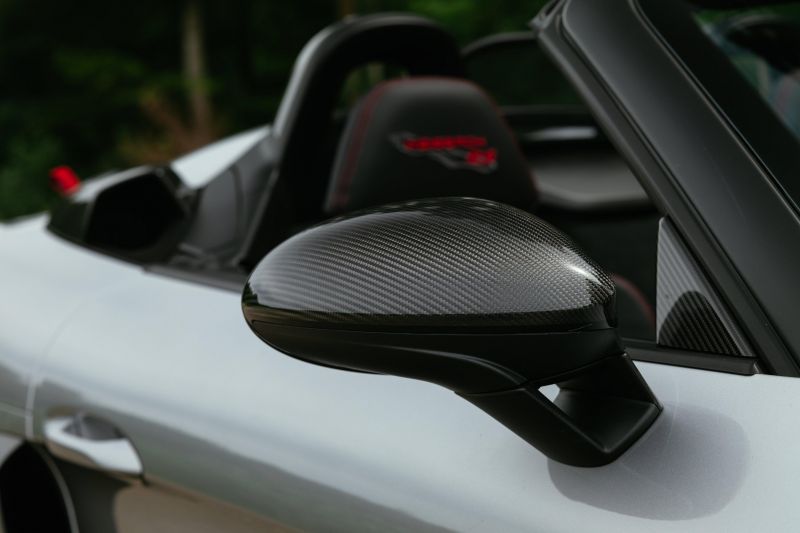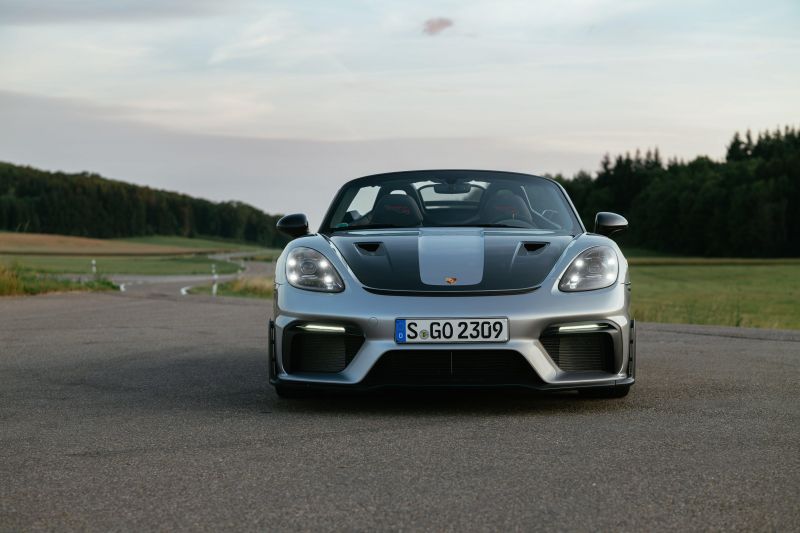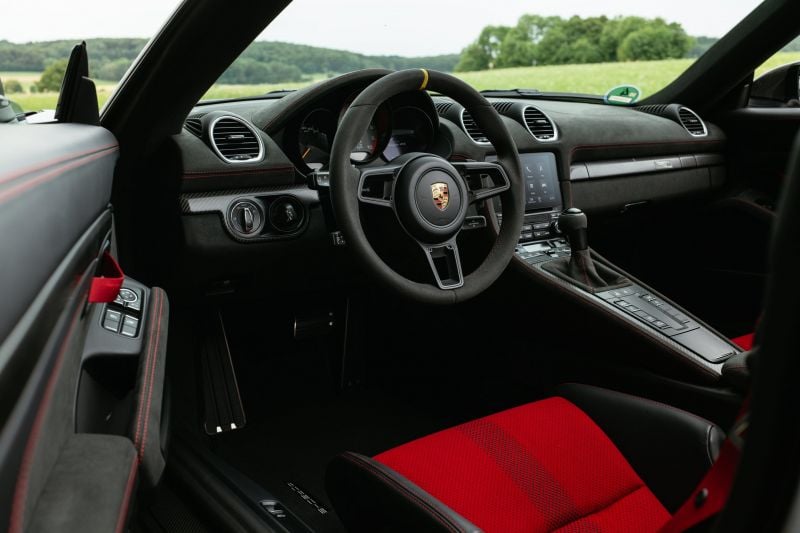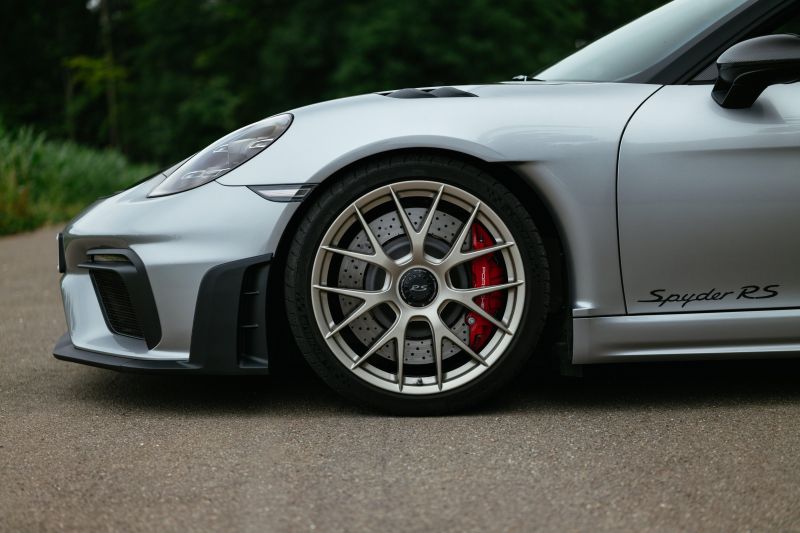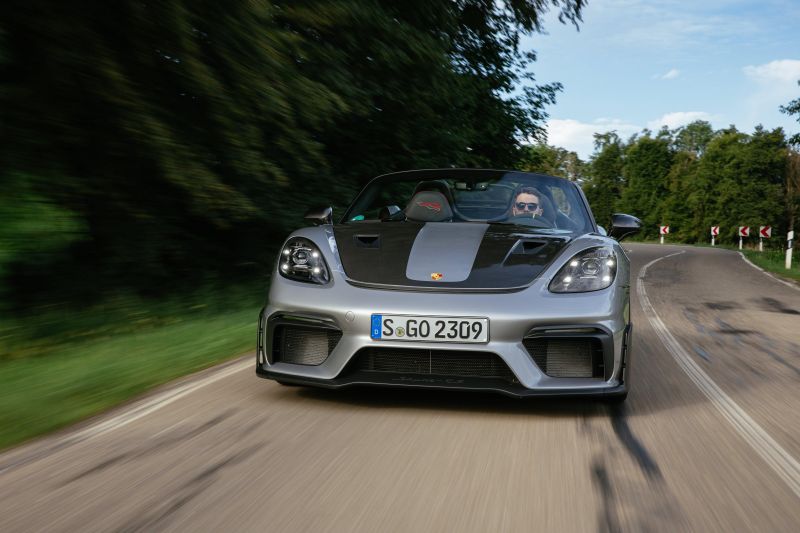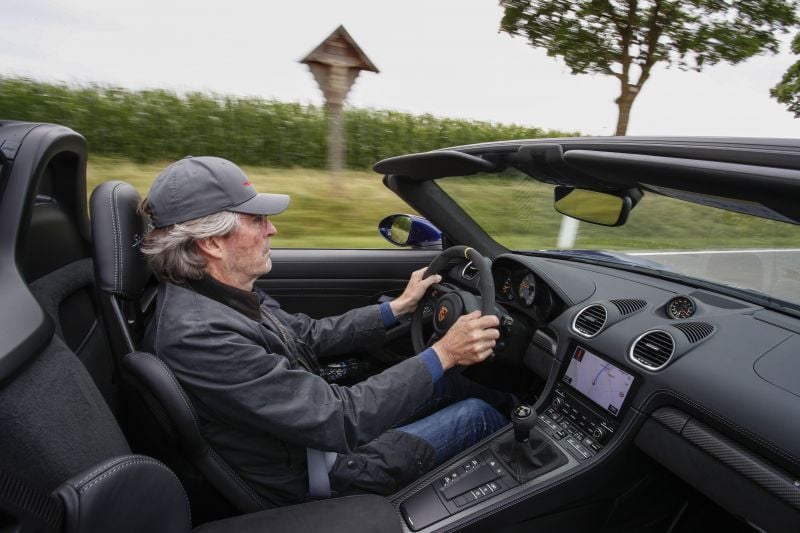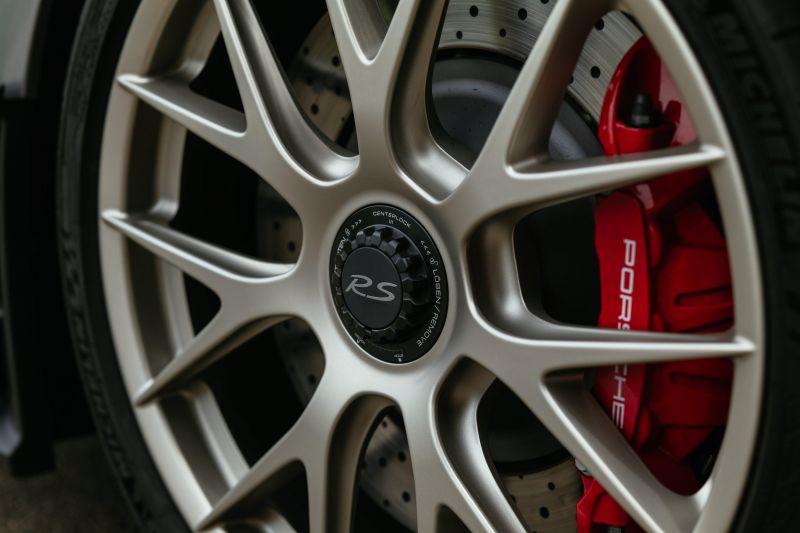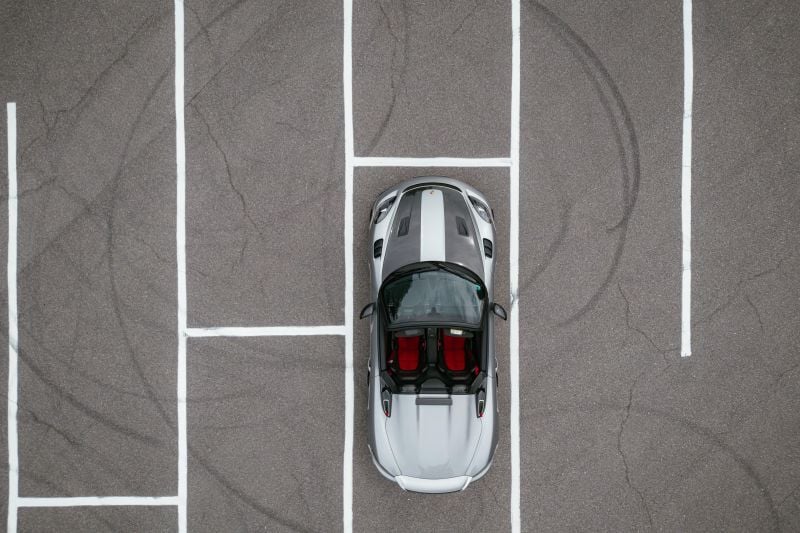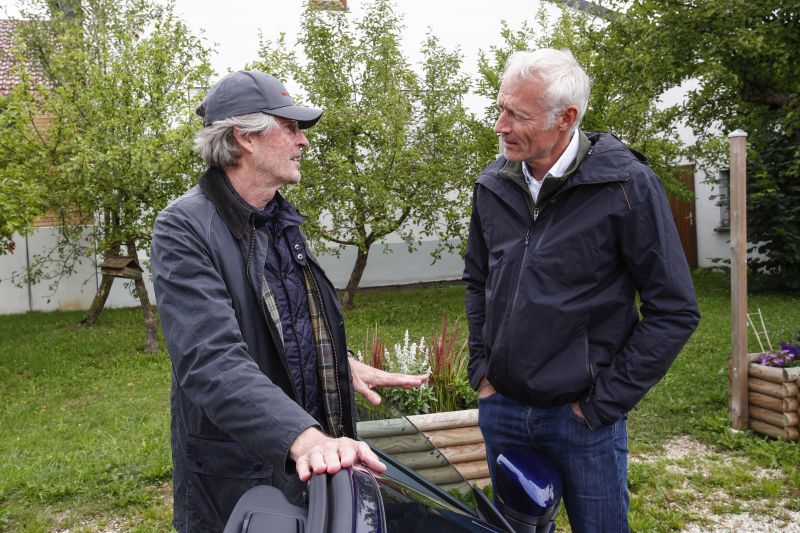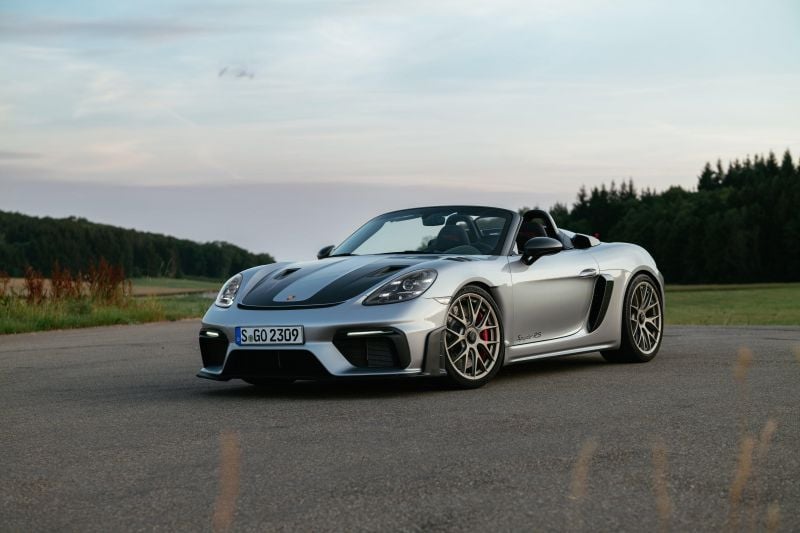The Porsche 718 Spyder RS is history on wheels.
This latest offering from the small engineering team that specialises in developing high-performance road and racing cars at the company’s famed Zuffenhausen R&D headquarters will be the last small Porsche roadster with a mid-mounted internal-combustion engine.
“It’s the last hurrah for the mid-engine platform,” confirms Porsche GT chief Andy Preuninger. And it’s a car that hews to a proud tradition that stretches back to racing machines such as 1959 718 RSK Spyder and the 1953 550 Spyder. “Building light and powerful roadsters is what Porsche has done from day one,” he says.
The 718 Spyder RS is not merely an open-top version of the track-focused Cayman GT4 RS coupe. While they share the same powertrain, the Spyder RS has a chassis that’s been set up more for fast road driving.
The Spyder’s front and rear spring rates are thus 55 per cent and 43 per cent softer, respectively, than those of the Cayman GT4 RS, with shock and stabiliser bar settings adjusted to suit. The ride height has been dropped 30mm compared with the regular Boxster while the GT4 rolls 50mm lower to the tarmac than a standard 718 Cayman.
The other big difference between the two cars is in their aerodynamic setup. The roadster doesn’t get the towering, fixed rear wing that makes the coupe’s track day intentions crystal clear. Instead, there’s a large ducktail spoiler whose form echoes the one on the iconic 1972 Porsche 911 Carrera RS 2.7.
The ducktail produces less downforce than the GT4 RS wing, and so to preserve the aero balance, the front splitter on the Spyder RS has been shortened 50mm, and the downforce-inducing vanes under the front floor removed. Subtle changes have also been made to the steering of the 718 Spyder RS to make the car feel less darty the moment you pull the steering wheel off-centre.
“We are always on the quest for the ultimate driver’s car,” Preuninger says of the GT engineering team’s role within the Porsche R&D operation. “We have two options: One is something for the track rats, for the enthusiasts that do track days, and the other is for guys like me that are maybe over chasing lap times and just enjoy GT technology in a road car.”
How much does the Porsche Boxster 718 Spyder RS cost?
Enjoying that GT technology comes at a price. Drive-away prices range from $359,682 to $375,117 in Australia, which represents a $140,000 or more increase over a Boxster GTS 4.0.
Unlike most convertibles, which usually cost more than their coupe counterparts, the 718 Spyder RS costs same as the Cayman GT4 RS.
What is the Porsche Boxster 718 Spyder RS like on the inside?
Just as the exterior styling of Spyder RS make it clear this is the fastest of the open-top 718s you can buy, the interior boasts familiar Porsche performance car features.
There are no interior door handles, for example. To exit the Spyder RS, you pull on a nylon band, just as you would getting out of a Porsche 911 GT3 race car.
The steering wheel is covered in grippy microfibre, and carbon-fibre trim is used on the centre console, dashboard, and for the kick plates.
Despite its lightweight, stripped-down demeanour, the 718 Spyder RS is well equipped, with power windows, air conditioning, and sat-nav included in the standard equipment.
Standard seats are lightweight racing-style buckets with carbon-fibre shells, electric height adjustment and manual fore-aft adjustment. Adaptive sports seats with 18-way power adjustment are available as an option.
What you don’t get at any price, though, is a powered soft-top. Making the 718 Spyder RS cockpit weatherproof involves a ritual that goes back to the earliest days of open-top sports cars.
First, you must unpack and unroll a top stored under the rear decklid and secure it to the windshield header rail with a single clip and to two location points near the storage space.
Then you clip on and secure a vertical element with an in-built rear window across the rear. Finally, you close the rear decklid and secure the trailing elements of the top to the locating points atop the air intakes.
It’s a bit like erecting a tent, and Porsche doesn’t recommend exceeding 200km/h with the roof in place, but once it’s all buttoned up the cabin of the Spyder RS stays snug and dry. And noticeably quieter, too. On hot days you can choose to put the top up without the rear element attached, allowing fresh air to stream through the cabin.
The Spyder RS’s top weighs just 18.3kg, making it 7.6kg lighter than the regular Spyder roof, and 16.5kg lighter than the mainstream Boxster roof, and helps contribute to the car’s 1410kg overall weight, which is, impressively, 5kg less than the 718 Cayman GT4 RS weighs. But weight saving wasn’t the core reason for the complex roof design: The regular Spyder soft-top simply wouldn’t fit.
What’s under the bonnet?
This is the reason for the special soft-top: Like the GT4 RS, the Spyder RS is powered by the same glorious 4.0-litre naturally aspirated, dry-sump flat-six used in Porsche’s GT3 road and race cars.
And, the engine’s different intake system means it’s taller than the less highly tuned 4.0-litre engine that powers the regular Spyder. There was simply no room to package a conventional soft-top between the top of the engine and that long rear deck lid.
As in the GT4 RS, the Spyder RS makes marginally less power and torque than in the 911 GT3, thanks to the different exhaust and cooling system layouts dictated by its location in the chassis. But it is still a Porsche powerplant for the ages.
It makes 450Nm at a heady 6250rpm and 368kW at a race-face 8400rpm as it zings to the same dizzying 9000rpm redline as in the 911 GT3. Revs? It loves them.
And that’s one reason the 718 Spyder RS comes only with a short-ratio version of Porsche’s seven-speed PDK dual-clutch transmission. The transmission’s lightning fast upshifts and razor-sharp rev-matching on downshifts perfectly suit the engine’s hyper-alert character.
The other reason? The manual transmission used in regular 718s can’t handle the GT3 engine’s power and the torque.
How does the Porsche Boxster 718 Spyder RS drive?
The 718 Spyder RS might be pitched as the GT4 RS’s slightly softer sibling, but that doesn’t diminish the car’s intoxicating appeal.
In fact, the Spyder might be the better all-rounder, as composed on lumpy country roads as it is on super-smooth racetracks. It may have been optimised for the road, but it’s scarcely compromised.
Through smooth and tractable at low speeds, the 4.0-litre flat-six can feel a little sleepy below 3000rpm, especially when you’re cruising with the transmission in auto mode and want to overtake slower moving traffic (despite the short gearing, 3000rpm in seventh gear equals about 110km/h).
But a simple flick of the central shifter to the left to put the transmission into manual mode and a press of the Sport button (there is no Sport+ mode) allows you to wake everything up.
The engine sparkles anywhere above 4000rpm, and that 9000rpm redline gives you a lot of room in which to play with its responsive power delivery. The lightning-fast response of the PDK transmission means it’s easy to keep the engine in its happy place.
“It fits the car as a driver’s car almost better than any manual,” says Preuninger, a telling comment from the man whose trend-defying 911R paved the way to keeping the traditional manual transmission alive in modern 911s.
The Spyder RS will sprint to 100km/h in 3.4 seconds, half a second less than it takes the regular Spyder, and hit 200km/h in 10.9 seconds on the way to a top speed of 308km/h. But it’s what it does in the corners that will really make you smile.
The PDK transmission allows you plunge the Spyder RS deep into corners, left foot braking to make the most of the abundant front-end grip, and to enable you to go to power much quicker than you can in a three-pedal car.
Despite the softer suspension there’s no noticeable roll, dive, or squat in reaction to inputs from the steering, brake, and throttle, and it has better traction out of bumpy corners than the GT4 RS.
And then there’s the noise. Few open-top cars, apart from perhaps the Lamborghini Huracan Evo RWD Spider with its glorious naturally-aspirated 5.2-litre V10, can deliver the aural drama of the 718 Spyder RS at full throttle.
With its air intakes mounted outboard of the roll-over bars, the 4.0-liter engine sounds louder and angrier and edgier that it does in a 911 GT3.
It’s almost too loud. You won’t want to drone the 718 Spyder RS down the Hume Highway. But that’s not what it was designed to do. No, the 718 Spyder RS is meant for short, roof down sorties along quiet country roads.
It has the talent to enable you to drive it as hard as you dare when circumstances allow, but the manners to allow you to enjoy the sublime powertrain and chassis even when loafing along at little more than six-tenths.
What do you get?
This is the most expensive mid-engine Porsche roadster you can buy.
718 Boxster Spyder RS highlights:
- 20-inch forged alloy wheels
- 245/35 front, 295/30 rear tyres
- 408mm front, 380mm rear brake discs
- 8.0-inch touchscreen infotainment system
- Apple CarPlay
- Automatic headlights
- Auto-dimming rear mirrors
- Carbon-fibre bonnet, front guards,
- Carbon-weave door sill trims
- Cruise control
- DAB+ digital radio
- Door opening loops (not handles)
- Dual-zone climate control
- Dynamic transmission mounts
- Extended range fuel tank – 64L
- Full bucket seats
- LED headlights
- Lightweight CFRP bucket seats
- PASM sport suspension (lowered 30mm)
- Porsche Torque Vectoring (PTV) with mechanical-locking differential
- Porsche stability management with ESC OFF, ESC + TC OFF modes
- Tyre pressure monitor with track mode
- Rear parking sensors
- Reversing camera
- Satin carbon interior trim
- Satellite navigation
- Stainless steel exhaust
- Steering wheel rim with top centre marking in yellow
As is usual with Porsche, 718 Spyder RS buyers can choose from a huge array of options.
Key performance options include PCCB carbon-ceramic brakes for $14,960, and the $22,610 Weissach Package that adds the following:
- Carbon-weave finish accents
- Bonnet
- Exterior mirror upper trims
- Cooling air intake trim behind driver and passenger doors
- Air intakes behind driver and passenger
- Housing upper part 3rd brake light
- Trim for roll-over bar
- Aerodynamic flap (Gurney flap) on fixed rear spoiler
- Titanium tailpipe trim in 935 look.
- Weissach Package logo embossed on convertible top and headrests
- Dashboard upper in Race-Tex
- Weissach Package logo on dash badge
Ordering the Weissach Package also allows you to order the optional and ultra-light forged magnesium 20-inch alloy wheels, which will set you back a breathtaking $28,110.
A 718 Spyder RS in the standard white, black, Guards Red, or Racing Yellow fitted with all those goodies plus the $4900 hydraulic front axle lift, which raises the front ride height by 30mm to help negotiate gutters and driveways, and the $520 Sport Chrono Package will set you back $441,685.
That’s still almost $7000 less than what you’ll spend on a ‘base’ 911 GT3.
Is the Porsche Boxster 718 Spyder RS safe?
The 718 Spyder has driver and passenger airbags and roll over hoops, as well as anti-lock brakes plus traction and stability control. In other words, the fundamental active and passive safety systems.
There is no blind-spot warning, autonomous emergency braking, lane-keep or rear cross-traffic assists, nor is there adaptive cruise control.
How much does the Porsche Boxster 718 Spyder RS cost to run?
The 718 Spyder RS might have what is essentially a racing engine, but if you look after it, ensuring it is correctly serviced, it should be no less reliable than any other modern Porsche flat-six engine.
“Treat it right, and it will last forever,” says Andy Preuninger.
Not that treating it right means paying constant attention: Maintenance is required every 12 months or 15,000 kilometres, whichever comes first.
Porsche also offers a three-year, unlimited-kilometre warranty as well as a three-year paint warranty and 12-year rust coverage.
CarExpert’s Take on the Porsche Boxster 718 Spyder RS
Lighter and louder than the GT4 RS coupe, with a supremely capable chassis underpinned by suspension that’s arguably better judged for real-world roads, the 718 Spyder RS is perhaps the best open-top, road-going Porsche ever built.
It’s a sports car you can’t help but enjoy driving; fast and responsive, agile and balanced, viscerally engaging at any speed.
What makes it even more special is the bittersweet realisation that it’s the last of the line, the last mid-engine Porsche roadster with an internal combustion powertrain.
And, Andy Preuninger and his team have made sure it’s a swansong that won’t be forgotten: “We chose the best engine we think we have for the ultimate roadster.”
Too right. The Porsche 718 Spyder RS is an instant classic.
Click the images for the full gallery
MORE: Everything Porsche 718

